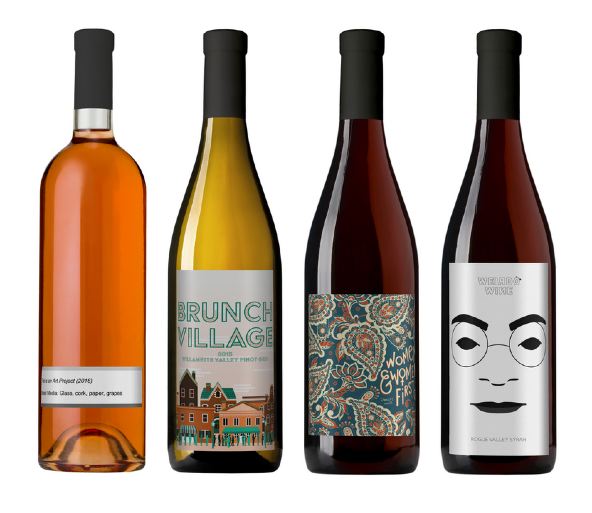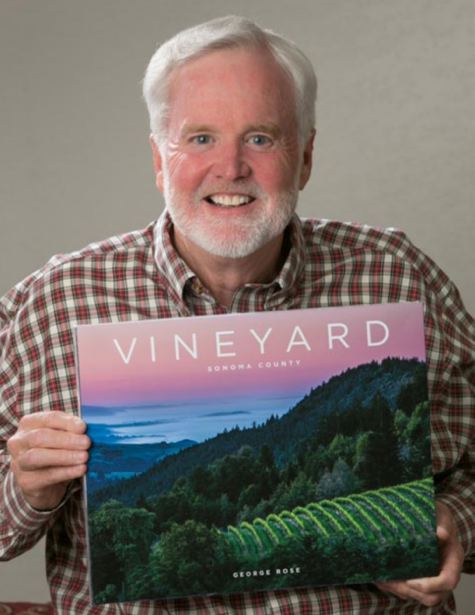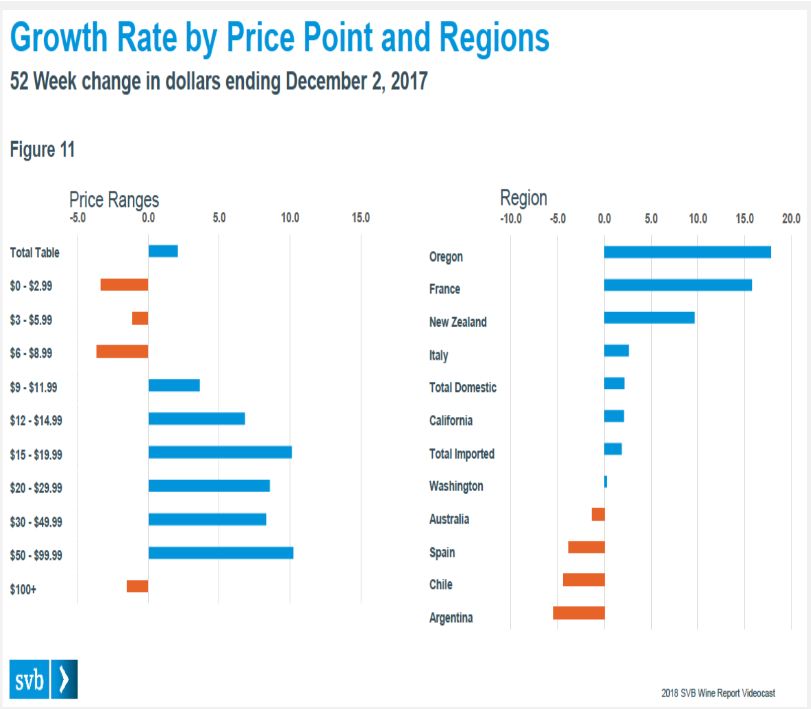Pinot Briefs
—Newsletter 11.18
North Coast Wildfire Impact Study The Wine Business Institute (WBI) at Sonoma State University
released preliminary findings of its wildfire impact study of the North Coast wine industry, based on a survey of
more than 200 vineyard and winery stakeholders across Lake, Mendocino, Napa, Solano, and Sonoma
counties. While the wildfires were unprecedented in Northern California, the findings indicate the actual impact
on the North Coast wine industry was localized and limited. The most significant impact on the North Coast
wine industry was an immediate and temporary slowdown of visitors to the region. Presumably this was due to
images and reports at the height of the disaster. 99.8% of vineyard acres in the North Coast region were
unaffected by recent fires. 93% of wineries were reported as unaffected in terms of structural damage or long-term
impact. 99.5% of the total crop value was recovered. Many survey respondents reported a drop in tasting
room traffic and sales, with visitation from outside California and the U.S. was most affected. Beginning in
November, visitor traffic and tasting room sales returned to near normal. Other wine regions in the state
reported a significant increase in visitor numbers during this period. Over $15 million in charitable contributions
have been made through a local credit union and other channels in support of those directly impacted by the
fires. For further information, visit www.sonoma.edu/winebiz.
New Lot 18 Wine Collection Lot 18, Broadway Video Enterprises and IFC unveiled a new wine
collection inspired by the hit television series ‘Portlandia.’ The Oregon wines are based on some of the show’s
most memorable sketches. Each bottle is accompanied by a specially designed label. The wines, in limited
production, went on sale January 18 and can be ordered exclusively at www.Lot18.com/Portlandia while
supplies last. The lineup of four wines includes ‘2016 Women and Women First Willamette Valley Pinot Noir.’

SIP McMinnville Wine & Food Classic SIP is celebrating its Silver Anniversary of the McMinnville
Wine & Food Classic, March 9-11, at the Evergreen Aviation and Space Museum. The festival brings together
about 170 small independent producers of Oregon wine, beer, liquor, food and art for three days of tasting,
toasting, and raising funds for St. James Catholic School in McMinnville, founded in 1906. Attendees can order
through a streamlined system, allowing them to pick up at a valet counter upon leaving the festival. Beginning
February 1, day pass tickets are $20 for adults and $17 for seniors and designated drivers. After entry, patrons
pay for each tasting or food item on an individual basis. For more details, visit www.sipclassic.org and to plan
your time in the area, visit www.visitmcminnville.com/.
Le Paulée de San Francisco The La Paulée Burgundy Festival in San Francisco February 27-March
3, 2018, allows guests to sample current releases and older vintages from some of the most sought-after
domaines of Burgundy. The wine service is led by over fifty of the nation’s notable sommeliers. Tickets are now
on sale including offers exclusively for American Express card members at www.lapaulee.com.
Setting the Record Straight A reader pointed out to me that many writers and references attribute
the success of Oregon Pinot Noir to the fact that the Willamette Valley and Burgundy are at the same latitude.
The truth is, they aren’t! The Willamette Valley is at 45 degrees latitude, while Burgundy is at 47 degrees
latitude including the Côte d’Or. 47 degrees in the United States would put you in Tacoma, Washington and 45
degrees in France would put you much closer to Bordeaux. Also, the 45th parallel runs through St. Paul,
Minnesota and Ottawa, Canada (try growing Pinot Noir in either of those places). Another perpetuated myth
has been debunked!
Golden Gate Wine Cellars Owner Frank Melis stocks very hard-to-get domestic Pinot Noir wines that
are usually only available to winery mailing list customers. He is able to buy directly from the winery at
wholesale prices and sell the wines at retail prices. Golden Gate Wine Cellars, started in June of 2005,
specializes in boutique California wineries. Melis previously ran another high-end wine retail store in San
Francisco for over a decade. He organizes weekly wine tastings, hosts winery owners and winemakers and
every year conducts one large wine tasting out-of-state. His portfolio includes Pinot Noir wineries such as Paul
Lato, Mail Road, (DuMOL - Melis was their first retail client), Cattleya, and Pisoni. You can also find wines from
Colgin, Screaming Eagle, Harlan, Bench, Kamen, and Kongsgaard. Visit the website at
www.goldengatewinecellars.com or contact Frank Melis directly if you are looking for something special at
frank@ggwc.com.
Top Ten Wine Grape Varieties in the World Per and Britt Karlsson composed an article at
www.forbes.com that breaks down the planted acreage of the most widely planted grape varieties. The most
grown grape variety for wine is Cabernet Sauvignon (840,000 acres). Number two is Merlot, three is
Tempranillo, four is Airén (a white grape used in Spain for unpretentious wines), five is Chardonnay, six is
Syrah, seven is Grenache Noir, eight is Sauvignon Blanc, nine is Pinot Noir (285,000 acres), and ten is
Trebbiano Toscano/Ugni Blanc.
DRC’s Aubert de Villaine Thinks 2015 Most Remarkable Vintage of His Career de
Villaine spoke to the drinks business at https://www.thedrinksbusiness.com/2018/01/de-villaine-2015-is-themost-
remarkable-vintage-of-my-career/. He said, “I have never seen a season where the vineyards were so
beautiful from beginning to end.” He went on to say in reference to the wines, “They have a serenity and
peacefulness about them that was a reflection of the well-being of the vineyards.” This is a remarkable
statement considering de Villaine has participated in over fifty vintages. DRC used 100% whole cluster in 2015,
only employed recently in 2005 and 2009. DRC has always used some whole cluster in fermentations, but the
portion used in this manner must have high maturity and ripening to ensure the stems don’t transmit a stalky
character to the wines. Yields in 2015 for every DRC bottling were smaller than in 2014. The smaller harvest
and superiority of the vintage has led to a rise in prices between 17%-31% depending on the bottling.

New Book: ‘VINEYARD: Sonoma County’ George Rose is a well-known wine photography based
in Sonoma County. In this book, he shows the diversity and personality of vineyards through photographs he
has accumulated in over 25 years exploring Sonoma County. The last photograph in the book is of Paradise
Ridge and its beloved LOVE sculpture at sunset, before the October wildfires. This sculpture survived the fire
and has become a symbol of Santa Rosa’s community coming together in the recovery process. The book
($80) is available at www.georgerose.com. Some of the profits of the sale of the book will be donated to the
Sonoma County Grape Grower Foundation to support vineyard workers who were displaced by the fires.

MIT Biochemical Engineer May Save Pinot Noir from Warming Climate Change At
Massachusetts Institute of Technology, biochemical engineer Jean-Francois Hamel has discovered the secrets
to how natural yeasts affect flavors and alcohol levels in wine and in turn may save wine grapes from the
damaging effects of climate warming. An an article written by Elon McCoy appeared in BloombergPursuits,
https://www.bloomberg.com/news/articles/2018-01-23/winemakers-turn-to-mit-to-save-pinot-noir-in-warmingtemperatures.
Hamel, a Frenchman, was enlisted by Oregon Chapter 24 winery owner Mark Tarlov and its
winemaker Louis Michel Liger-Belair to try to figure out how indigenous yeasts in their vineyards could make
elegant and complex wines even with increasingly warm temperatures. The results of Hamel’s research have
been bottled and the winery’s first single-vineyard Pinot Noir wines will be available beginning February 1
($120 a bottle). Chapter 24 has found that each of their vineyard sites has its own mix of wild yeasts that
contribute to the terroir of the vineyard. The primary yeast for winemaking, Saccharomyces cerevisiae acts on
grape sugars and produces high levels of alcohol. It competes with the weaker non-Saccharomyces types and
together they produce many different flavors and aromas. The non-Saccharomyces types tend to produce less
alcohol. Both yeast types need oxygen to thrive. For the 2016 vintage, Chapter 24 used hand-sprayed aerobic
pump overs at the beginning of fermentation to provide additional oxygen and allow non-Saccaromyces yeasts
to survive longer. The result is that the 2016 Chapter 24 Pinot Noir wines had the same alcohol as wines from
the previous vintage, even though the weather during the 2016 growing season was much hotter. The results
suggest the possibility of producing Pinot Noir with lower alcohol levels and higher acidity without turning to de-alcoholization.
Hamel is directing further research into determining how much oxygen is ideal during
fermentation and how to precisely add it to control a wine’s eventual alcohol level. Four Chapter 24 Pinot Noir
wines grown in volcanic soils are being released to winery by allocation: 2016 Warden Hill ($120), 2016
Hopewell Hills ($120), 2016 Highland ($180) and 2016 Stone Creek ($180). The winery is located in Salem,
Oregon, and is open only by appointment. Visit www.chapter24vineyards.com.
Smoke Taint in Aftermath of California Wildfires An article was posted by Jessica Zimmer at
http://www.spiritedbiz.com/clearing-air-smoke-taint-aftermath-california-wildfires/. Winery owners who were
interviewed in Napa reported that the fires will have minimal effect on future wine quality. Most grapes were
already harvested prior to the Northern California fires because 2017 was a relatively warm year. Michael
Haney, interim executive director for Sonoma County Vintners said, “The idea that smoke taint affected this
year’s harvest has been inflated.”
Growth Rate of Wine by Price Point and Regions in 2017

Benovia Winery’s Customers, Friends & Family Donate nearly $400,000 to
Sonoma County Fire Relief Funds Benovia Winery is a small production, family-owned winery in
the heart of the Russian River Valley owned by husband-and-wife co-founders Mary Dewane and Joe
Anderson and winemaker Mike Sullivan. When the devastating fires broke out in October, friends of Benovia
pitched in immediately to offer financial assistance. Benovia pledged $100,000 in matching funds and when
donations totaling $199,000 poured in from friends of the winery across the country, Benovia’s $100,000
matching donation was quickly realized. Additionally, Benovia waived toasting room fees from October 24 -
December 31 and donated another $15,000 to the benefactors, the Redwood Credit Union North Bay Fire
Relief Fund, the Sonoma County Grape Growers Foundation’s Wildlife Housing Support Fund, and the
Sonoma County Community Foundation Resilience Fund. (Sullivan delivering donations in photo below)